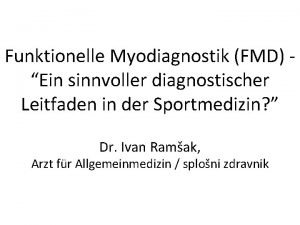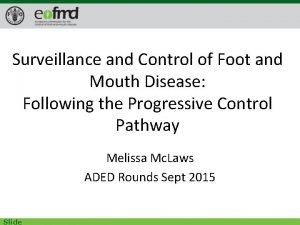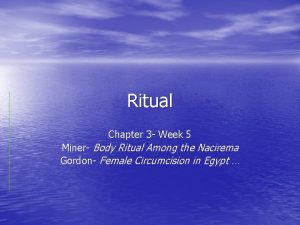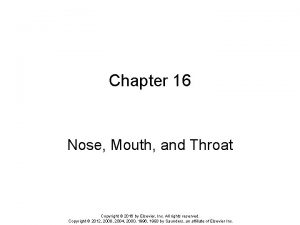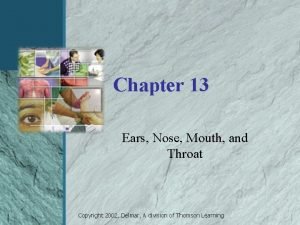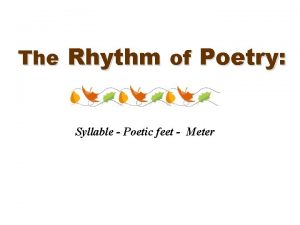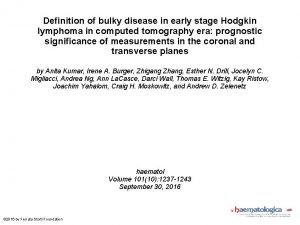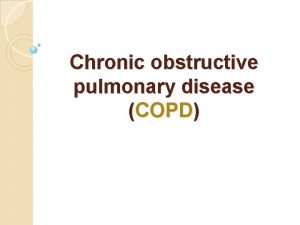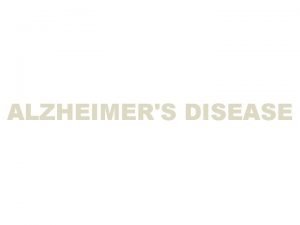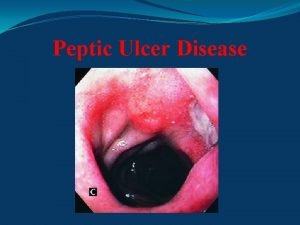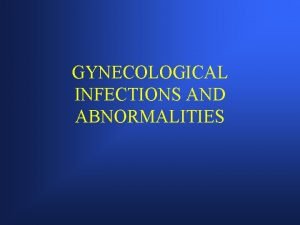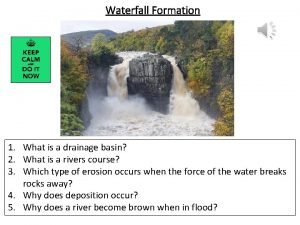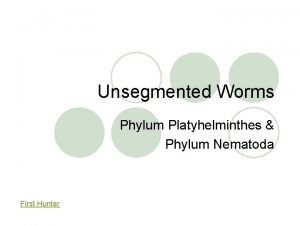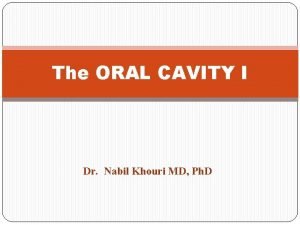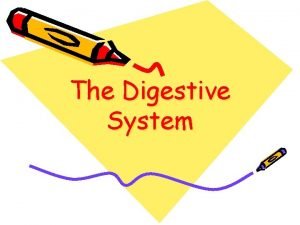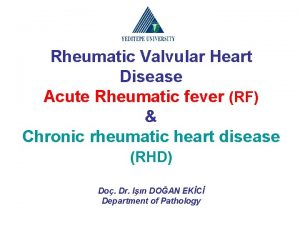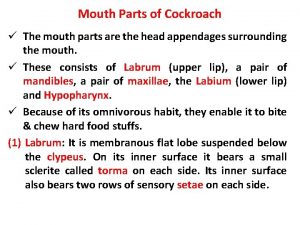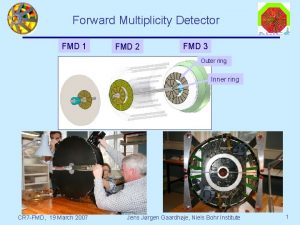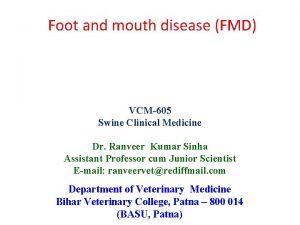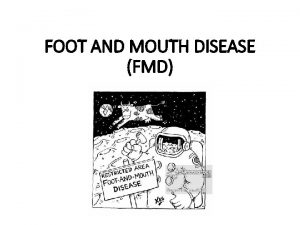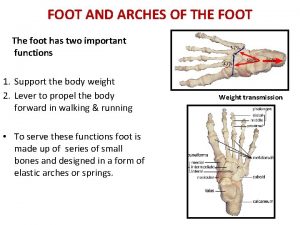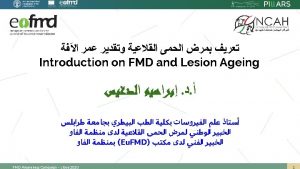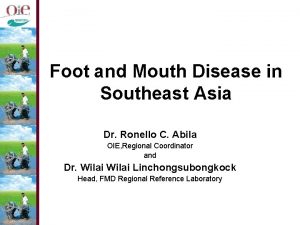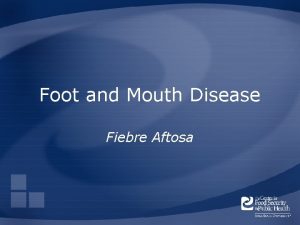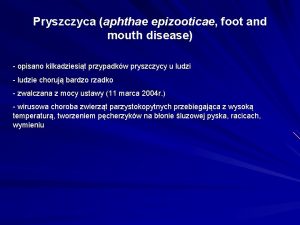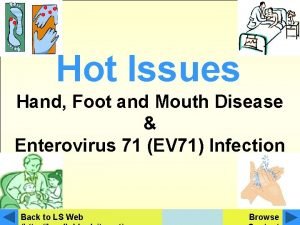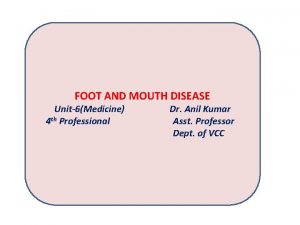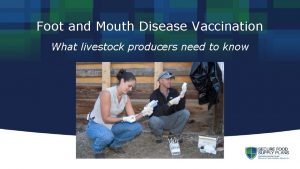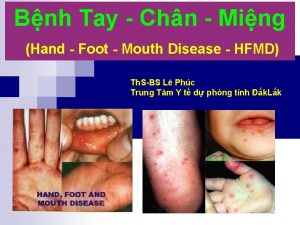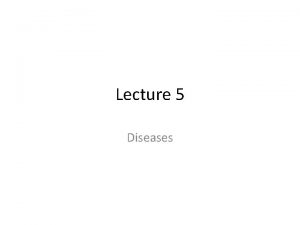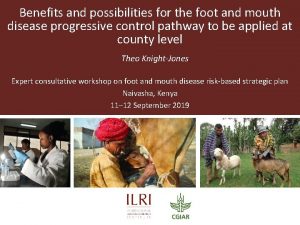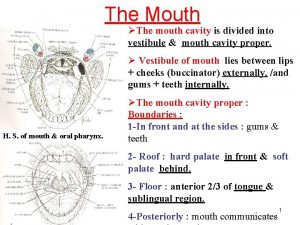FOOT AND MOUTH DISEASE 1 Definition FMD is






































- Slides: 38

FOOT AND MOUTH DISEASE 1

Definition FMD is a highly contagious viral disease of cloven footed animals characterized clinically by pyrexia, vesicular stomatitis and vesicular lesions on the skin of interdigital space and the coronary band. 2

3

The Virus Picornaviridae, Aphthovirus 7 distinct serotypes Not cross protective Affects cloven-hoofed animals Inactivation p. H below 6. 5 and above 9 Survives in milk, milk products, marrow, lymph nodes. bone 4

FMDV Seven serotypes O, A, C, SAT 1, SAT 2, SAT 3, Asia 1 South America- O, A, C Europe- O, A, C Africa- O, A, C, SAT 1, SAT 2, SAT 3 Asia- O, A, C, Asia 1 5

FMD virus is environmentally resistant and inactivates outside the p. H range 6– 9 and desiccation and at temperatures >56°C. It is resistant to lipid solvents such as ether and chloroform, but sodium hydroxide (lye), sodium carbonate (soda ash), citric acid, and acetic acid (vinegar) are effective disinfectants. Iodophores, quaternary ammonium compounds, hypochlorite, and phenols are less effective disinfectants, especially in the presence of organic matter. 6

Egypt has suffered from endemic FMD since the 1950. From 1950 until 1972 the country had several outbreaks with serotypes SAT 2 (1950), A (1952, 1956, 1958, 1972) and O (1951, 1958, 1961 -1962, 1964 -1977). During 1977 until the end of 2005 the country experienced only isolated serotype was O which appeared at regular times with mild clinical signs and mild economic losses. 7

In 2006, a new strain of serotype A entered Egypt with the imported cattle from Ethiopia and caused severe outbreaks with high mortalities in calves and severe clinical signs in cattle but had mild signs in buffaloes. In the period between 2006 and 2012, serotypes A and O were isolated on a regular basis and the vaccination strategy was changed to use bivalent vaccine with those FMD strains. In March 2012, there was another outbreak with a new serotype SAT 2 causing severe economic losses in large animal populations especially buffaloes with high mortalities in young calves and also latterly mortalities appeared in adult animals. 8

Serotype: or serovar is a distinct variation within a species of bacteria or virus or among immune cells of different individuals. These microorganisms, viruses, or cells are classified together based on their cell surface antigens, allowing the epidemiologic classification of organisms to the subspecies level. Topotype: A biological specimen that is of the same species or subspecies as a type specimen and has been collected from the same location. 9

In 1922 Vallée and Carré demonstrated that there were two serotypes of FMDV (Vallée & Carré, 1922). They named these Vallée O and Vallée A, after the regions they orginated from (department of Oise in France and Germany [Allemagne in French]). Four years later Waldmann and Trautwein demonstrated the existance of three serotypes (Waldmann & Trautwein, 1926). Which they named Waldmann A, B and C. Waldmann A and Waldmann B were found to be the same as Vallée O and Vallée A, respectively. While Waldmann C remained as a distinct third serotype. The names of Vallée O, Vallée A and Waldmann C were later shortened to O, A and C. Two new serotypes were identified in 1948 in samples from Bechuanaland (Botswana) and Northern Rhodesia (Zambia) (Brooksby, 1958). Retrospective testing of samples from Southern Rhodesia (Zimbabwe) from the 1930 s found both of these new serotypes and a third new serotype as well. These new serotypes were named Southern African Territories 1 to 3 (abreviated to SAT 1, SAT 2 and SAT 3). The serotype Asia 1 was identified in the early 1950 s in viruses isolated from India and Pakistan (Dhanda et al. , 1957 and Brooksby & Rogers, 1957 10

FMD surviving Virus remains viable § 14 days - dry fecal matter § 39 days - urine § 28 days - soil surface in fall § 3 days - soil surface in summer § 6 months - slurry in winter 11

Distribution: World-wide distributed. It is endemic in different localities: Africa Middle East Asia South America Free countries: FMD free without using vaccination (country or zone) FMD free with use of vaccination (country or zone) 12

13

To qualify for inclusion in the list of FMD free countries or zones where vaccination is not practised, a member country should have a record of regular and prompt animal disease reporting; send a declaration to the OIE stating that during the past 12 months, within the proposed FMD free country or zone: there has been no case of FMD; no vaccination against FMD has been carried out; supply documented evidence that for the past 12 months: The Member Country or the proposed free zone will be included in the list of FMD free countries or zones where vaccination is not practised only after the submitted evidence, based on the provisions of OIE. Retention on the list requires that the information in points be re-submitted annually and changes in the epidemiological situation or other significant events 14

FMD free country or zone where vaccination is practiced In defining a zone where vaccination is practiced. Susceptible animals in the FMD free country or zone where vaccination is practised should be protected by the application of biosecurity measures that prevent the entry of FMDV into the free country or zone. Taking into consideration physical or geographical barriers with any neighbouring infected country or zone, these measures may include a protection zone. Based on the epidemiology of FMD in the country has been accepted by the OIE. Member Country that meets the requirements of a FMD free country or zone where vaccination is practised wishes to change its status to FMD free country or zone where vaccination is not practised, it should notify the OIE in advance of the intended date of cessation of vaccination and apply for the new status within 24 15

Sources of infections: q The virus is present in q All sec. & excr. of the body q. Saliva q. Semen q. Faeces q. Urine qmilk q All meat and meat products: q. Bone, BM, viscera and LNs 16

Animal Transmission Respiratory aerosols Travel long distances Proper temperature and humidity Direct contact Vesicular fluid Ingestion Indirect contact via fomites Boots, hands, clothing 17

Human Transmission Clinical disease rare Infected by direct contact, ingestion of unprocessed milk/dairy products Type O, C, rarely A Transmit virus to animals Rarely harbor virus in respiratorytract for 1 -2 days Low risk of prolonged carriage Contaminated boots, clothing, vehicles 18

Factors affecting susceptibility Young ages are more susceptible All ages, sexes & breeds 19

E. value Meat and milk production are drooped. Impairment High of the international trade. mortalities in young animals. 20

Pathogenesis FMD gains access through inhalation and ingestion. Viremia occurs for 4 -6 days. Localisation and multiplication of the virus in the predilection tissues. Buccal cavities, pharynx, oesophagus, teats and muscles. Irritation and degenerative changes at these sites. Vesicles formation…. . Ruptured …may secondary bacterial infections. 21

The primary site of infection and replication of FMD is in the mucosa of the pharynx. The virus may also enter through skin lesions or the GI tract. Once distributed throughout the lymphatic system, the virus replicates in the epithelium of the mouth, muzzle, teats, feet, and areas of damaged skin (eg, knees and hocks of pigs). . 22

Vesicles then develop at the organs and rupture within 48 hr. More than 50% of ruminants that recover from illness and those that are vaccinated and have been exposed to virus can carry virus particles in the pharyngeal region—up to 3. 5 yr in cattle, 9 month in sheep, and >5 yr in African buffalo 23

Morbidity/ Mortality Morbidity 100% in susceptible animal population Higher U. S. , Canada and Mexico Less in endemic countries. Mortality Higher in young animals and highly virulent virus strain IP: 2 -14 days. 24

Clinical Signs: Cattle Pyrexia Oral lesions (vesicles) Tongue, dental pad, gums, soft palate, nostrils, muzzle Excess salivation, drooling, nasal discharge loss of body condition 25

Teat lesions Decreased milk production Hoof lesions Interdigital space Coronary band Lameness Reluctant to move 26

Clinical Signs: Pigs Hoof lesions More severe than in cattle Very painful Coronary band, heel, interdigital space Lameness Snout vesicles Oral vesicles less common 27

Clinical Signs: Sheep and Goats Mild, if any Fever Lameness Oral lesions 28

Post Mortem Lesions Single or multiple vesicles Various stages of development White area, 2 mm-10 cm Fluid filled blister Red erosion, fibrin coating Sloughed hooves Tiger heart 29

Differential Diagnosis Cattle Rinderpest, IBR, BVD, MCF, Bluetongue Sheep Bluetongue, contagious ecthyma 30

Sampling Before collecting or sending any samples, the proper authorities should be contacted Samples should only be sent under secure conditions and to authorized laboratories to prevent the spread of the disease 31

Clinical Diagnosis Vesicular diseases are clinically indistinguishable! Suspect animals with salivation or lameness and vesicles 32

Laboratory Diagnosis Initial diagnosis Virus isolation Virus identification RT-PCR Serology ELISA and virus neutralization Notify authorities and wait for instructions before collecting samples 33

Treatment Endemic Supportive Free countries: treatment countries: 34

Recommended Actions Notification of Authorities Area Veterinarian in Charge (AVIC) State Veterinarians Quarantine 35

Disinfection Products: 2% sodium hydroxide (lye) 4% sodium carbonate (soda ash) 5. 25% sodium hypochlorite (household bleach) 0. 2% citric acid Areas must be free of organic matter for disinfectants to be effective 36

Vaccination 37

Servac Polyvalent inactivated Foot and mouth disease oil vaccine (O, A&SAT 2) Type of vaccine: polyvalent inactivated oil vaccine. Host: cattle, goat and sheep. Packing unit: bottle contain 90 ml (30 dose for cattle) and( 60 dose for sheep and goat)) Dosage: First dose: cattle, buffaloes: 3 ml at 3 month Sheep , goat: 1. 5 ml. Second dose: after 3 -4 week from first dose. Revaccination 6 -8 month for high lactating cattle , buffaloes , sheep and goat. Method of use: shake vaccine and taken as one dose S/C. Storage: store at temp 4ºC for 2 years. Adverse effect: Post vaccination reaction : swelling at site of injection then disappeared two days later so cold omits recommended in this case. Recommendations: shaking well directly before vaccination. Never exposure to direct sunlight or heat. Vaccination taken to healthy animal only. Avoid vaccine freezing. 38
 Testliege
Testliege Fmd
Fmd Fmd
Fmd Communicable disease and non communicable disease
Communicable disease and non communicable disease You put your left foot in
You put your left foot in How to solve a right triangle
How to solve a right triangle Nacirema
Nacirema Jawless fish characteristics
Jawless fish characteristics The cleft connecting the nose and mouth to the larynx
The cleft connecting the nose and mouth to the larynx Mouth assessment normal findings
Mouth assessment normal findings Hi my name is junie b jones
Hi my name is junie b jones Poetic feet examples
Poetic feet examples Poetic meter and feet
Poetic meter and feet Foot in door technique
Foot in door technique Foot-in-the-door psychology example
Foot-in-the-door psychology example Social trap psychology definition
Social trap psychology definition Foot in the door phenomenon definition
Foot in the door phenomenon definition Foot binding definition ap world history
Foot binding definition ap world history Foot binding definition ap world history
Foot binding definition ap world history Acute and chronic apical periodontitis
Acute and chronic apical periodontitis Bulky desease
Bulky desease Hyprcapnia
Hyprcapnia Alzheimer disease definition
Alzheimer disease definition Gastric ulcer vs duodenal ulcer
Gastric ulcer vs duodenal ulcer Disease definition
Disease definition Dopamine blockers
Dopamine blockers Labeled diagram of a waterfall
Labeled diagram of a waterfall Small flat unsegmented worms
Small flat unsegmented worms Mylohyoid origin and insertion
Mylohyoid origin and insertion Path of food from mouth to anus
Path of food from mouth to anus Digestion in mouth
Digestion in mouth Digestive system for labelling
Digestive system for labelling Heart disease
Heart disease John kirby newcastle university
John kirby newcastle university Sludoy instrument classification
Sludoy instrument classification I had rather have this tongue cut from my mouth othello
I had rather have this tongue cut from my mouth othello Mouth preparation adalah
Mouth preparation adalah Mandibulate mouth
Mandibulate mouth Mouth parts of cockroach
Mouth parts of cockroach
